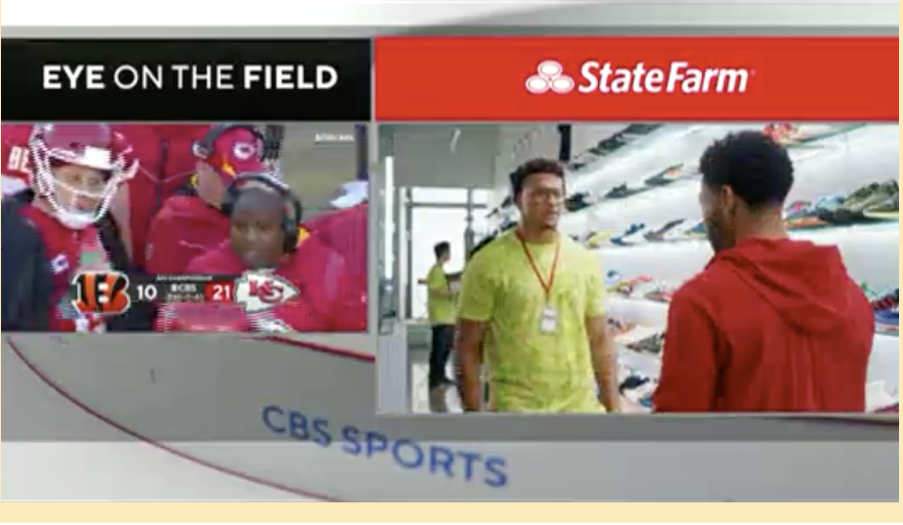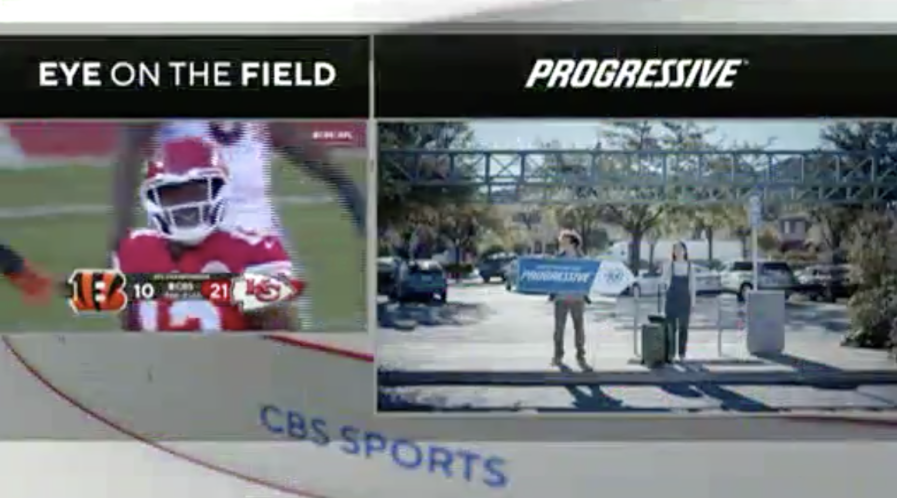The Picture-in-Picture (PiP) ad format is a powerful tool for advertisers, and EDO data from last week’s AFC Championship game on CBS proves it.
PiP ads, or ads that share the screen concurrently with a TV program, are not new. They are a particularly popular trend during live sports programming, as TV networks leverage PiP to keep its audience engaged throughout a game, especially during lulls in play. PiP also allows advertisers more opportunities to build brand awareness.
NFL fans may be particularly aware of PiP ads. On CBS, for example, when timeouts are called in the game, they may see a coach strategizing the team’s next play alongside an ad airing.

Typically when a viewer’s attention is split between two screens it is difficult to fully engage with either content. This raises the question: do PiP ads really engage viewers, or do they pay more attention to what’s happening on the field between plays?

Case Study: 2022 AFC Championship Game
The 2022 AFC Championship Game on CBS last week provides an excellent case study on how PiP ads perform.
During the game, both State Farm and Progressive used PiP ads to promote their brands. State Farm aired the 30-second spot Sneakerhead featuring Patrick Mahomes while Progressive aired the 30-second Sign Spinner: The Make Up ad.
During the 2022 Conference Championship Game, the average Progressive TV ad airing generated an additional 10,800 online searches. Similarly, the average State Farm TV ad airing during the Championship Game generated an additional 48,500 online searches. Thus, if a TV viewer’s attention is truly split while watching a PiP ad, that means that we would expect the Progressive and State Farm PiP ads to generate half the amount of Search Engagement.
In reality, we see that the Progressive PiP ad generated an SEV of 10.7 (equating to 10,700 additional online searches), and the State Farm PiP ad generated an SEV of 69.6 (equating to 69,700 additional online searches). These SEV scores for the PiP ads outperform our expectations by over 98%, highlighting how they drive ad performance for both brands.
Progressive PiP ad outperforms by 56%
The Progressive PiP ad outperformed the average Progressive TV ad airing during Primetime Broadcast by 56%. This means a TV viewer was 56% more likely to search online for Progressive after viewing the PiP ad during the AFC Championship Game, in comparison to the average Progressive airing during primetime broadcast.
Moreover, the Progressive PiP ad performed on par with the average Progressive ad during the Conference Championship Game. Not only is the PiP ad format outperforming expectations, but it is also performing on par with standard ads.
State Farm’s PiP ad outperforms by 288%
The case with State Farm is an even stronger example. The State Farm PiP ad outperform the average State Farm TV ad airing during primetime broadcast by 288%, and outperformed average State Farm airing during the Championship Game by 20%.
In other words, a TV viewer who saw the PiP ad was 288% and 20% more likely to search online for State Farm versus a primetime broadcast airing and an AFC Conference Championship Game airing, respectively. The State Farm PiP outperforms expectations given the split-viewing hypothesis and it outperforms the standard State Farm unit during one of the most valuable live sports programs.
While the PiP ad format does split the attention of a TV viewer, it is possible that – with the right program and right creative – an advertiser can successfully engage with consumers. As EDO has witnessed with this case study, not only did CBS maintain viewer engagement during a lull in the game, but Progressive and State Farm were able to generate additional online search thanks to the PiP ad format.
Interested in learning more? Find out what works for your brand and what your competitors are up to. Contact us today to learn how EDO can help you generate more consumer engagement.

